In the Moment:
Michael Frye's Landscape Photography Blog
by Michael Frye | Feb 15, 2015 | Composition, Light and Weather
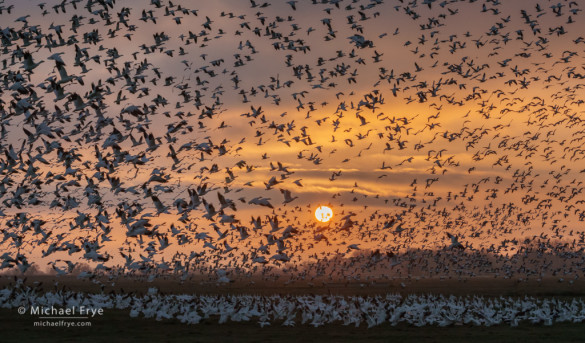
Ross’s geese taking flight at sunset, San Joaquin Valley, CA, USA
It should come as no surprise to any photographer that the interaction between subject and light is important. In fact, I’d say that this interaction is the essence of the whole thing; it’s what photography is all about.
But which comes first? Do you look for an interesting subject, and then find the right light for it? Or do you look at the light first, and then find a subject that fits the light?
I think both approaches can work. But having said that, I almost always think about light first. What’s the light now? What might happen to the light in the next five minutes, ten minutes, hour, or two hours? I try to anticipate how the light and weather might change, decide what kind of subject(s) could work with that light, and only then decide where to go.
(more…)
by Michael Frye | Nov 21, 2014 | Composition, Vision and Creativity
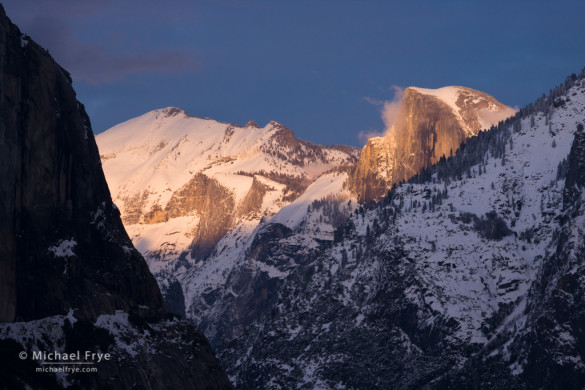
Half Dome at sunset from Tunnel View, Yosemite. The dramatic light might grab your attention here, but the interlocking diagonal lines create a cohesive design and a sense of energy.
One of the keys to learning composition is to think abstractly. As Ian Plant says in his excellent ebook about composition, Visual Flow, “Learning to think abstractly about visual elements is the single most important thing you can do to improve your compositional skills.” The less you think about the subject, and the more you think about the underlying abstract design – the lines, shapes, and patterns – the better your compositions will be.
It’s often easier to think abstractly when photographing a small subject, like a pattern of leaves, or a series of cracks in ice. But it’s just as important to look for repeating lines and shapes in big, sweeping landscapes. One of the most common – and powerful – designs in these big scenes is a series of interlocking diagonal lines. Most hilly or mountainous areas have an abundance of diagonals, and diagonal lines give a photograph a sense of dynamic energy and motion – a perfect fit for dramatic landscape images.
(more…)
by Michael Frye | Aug 6, 2014 | Composition, Vision and Creativity
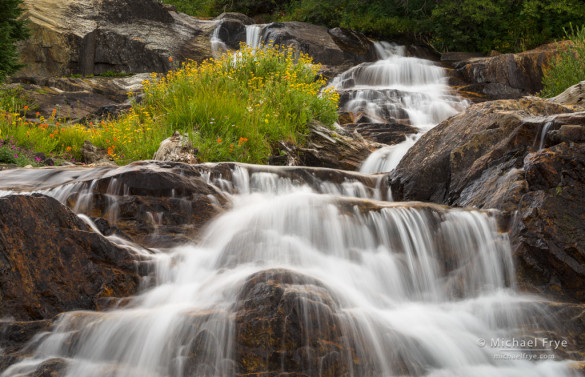
Wildflower island and cascade, eastern Sierra; 100mm, 1/2 sec. at f/16, 100 ISO
It’s been an interesting summer in the Sierra. Last winter was one of the driest on record, but over the last month or so we’ve seen a steady flow of monsoonal moisture flowing up from the southeast, leading to frequent afternoon showers and thunderstorms over the higher elevations. We even heard about an epic deluge two or three weeks ago that flooded the parking lot and some of the tent cabins at the Tuolumne Meadows Lodge.
That extra moisture has kept the streams flowing and flowers blooming in the high country longer than I would have expected. On Saturday Claudia and I hiked up one of the eastern Sierra canyons and found a pretty series of cascades, with an island of late-summer flowers in the middle.
Although I make my share of black-and-white photographs, I’ve always been attracted to color. I often look for color, then try to build a composition around it. As I tell my workshop students, color isn’t enough – you need to find a design to go with that color.
In this case, that design proved to be elusive. The most obvious composition was a wide-angle view with a patch of flowers at the bottom, and the upper cascade above. But there was a distracting pile of logs at the base of the cascade that cluttered the image, with no obvious way to eliminate or minimize the logs. I have nothing against logs, but in this case I was interested in the flowers and water, and the logs broke up the visual flow between the flowers and water, diluting the photograph’s message:
(more…)
by Michael Frye | Jul 3, 2014 | Critiques
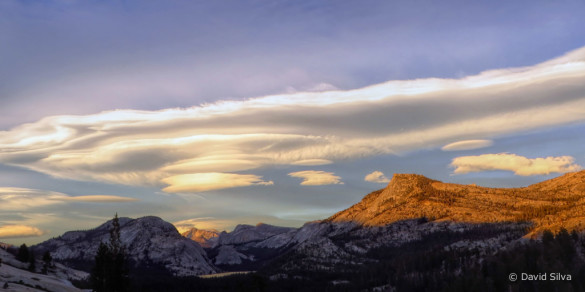
Lenticular Clouds, Tioga Pass, Yosemite, by David Silva
It’s been awhile, but I thought it was time to post another photo critique. This time I’ll look at an image by David Silva from Yosemite’s high country.
Light and Weather
David found some amazing lenticular clouds flowing over Yosemite’s high peaks just before sunset. (Where was I that day?) David told me that he and his wife were driving over Tioga Pass to the eastern Sierra when he noticed some interesting clouds forming. He considered stopping earlier, but decided to push on to Olmsted Point, and was able to make it there in time to catch the light on the clouds and peaks before the sun set.
This was perfect timing. There’s a nice orange glow on the highest peaks, creating a warm-cool color contrast. The last light highlights Mt. Conness in the distance, creating a small-but-important focal point. The clouds fit into the gap between the peaks is perfectly. There’s a beautiful, dramatic, late-day mood to the scene.
(more…)
by Michael Frye | Dec 23, 2013 | Announcements
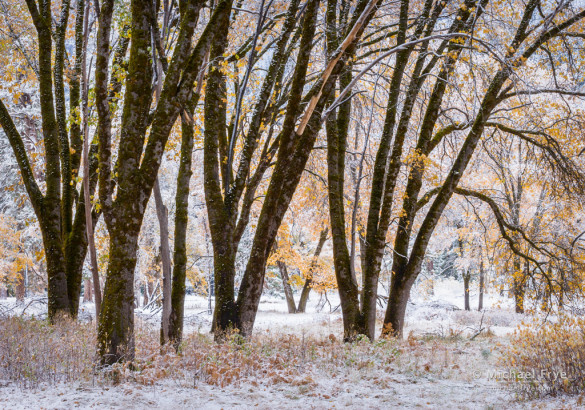
California black oaks after a snowstorm, Yosemite Valley. With forest scenes, it’s important to find as much spacing and separation between tree trunks as possible.
If light is the most important element in photography, composition is just a whisker behind. They’re both essential, and can’t be completely separated: a good composition has to take lighting into account, and you can’t think about light without considering how the light complements the subject. I already highlighted my post from last January about creating depth, but I also wrote three more posts this year about composition.
I’ve seen many otherwise excellent photographs ruined by a visual merger between important elements of the composition. When Separation is a Good Thing explains how to become conscious of these mergers and avoid this problem.
In Courting Luck, Part 2: Adapting Your Composition to the Conditions, I talk about what why I think it’s more productive to keep your compositions fluid and flexible when the light is changing quickly. And What’s the Least Interesting Part of This Photograph? is an exercise to help you tighten and strengthen your compositions.
— Michael Frye
(more…)













